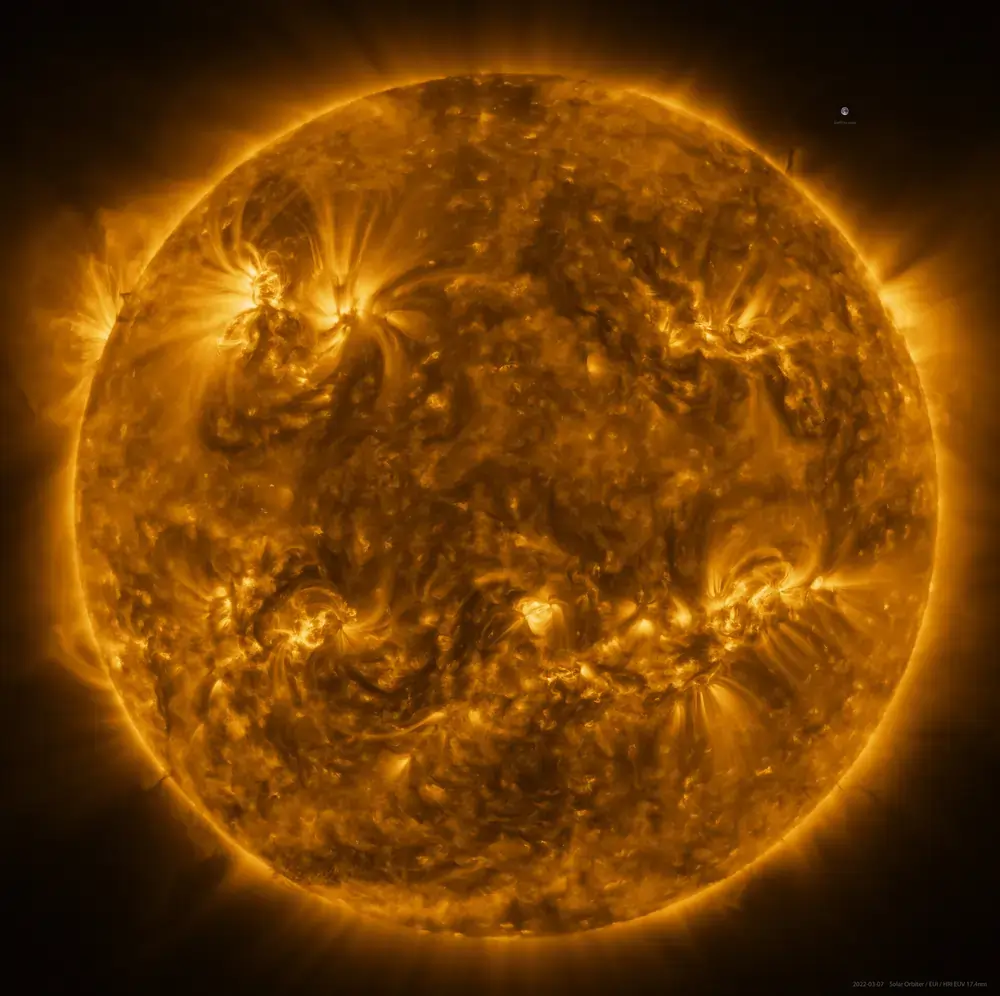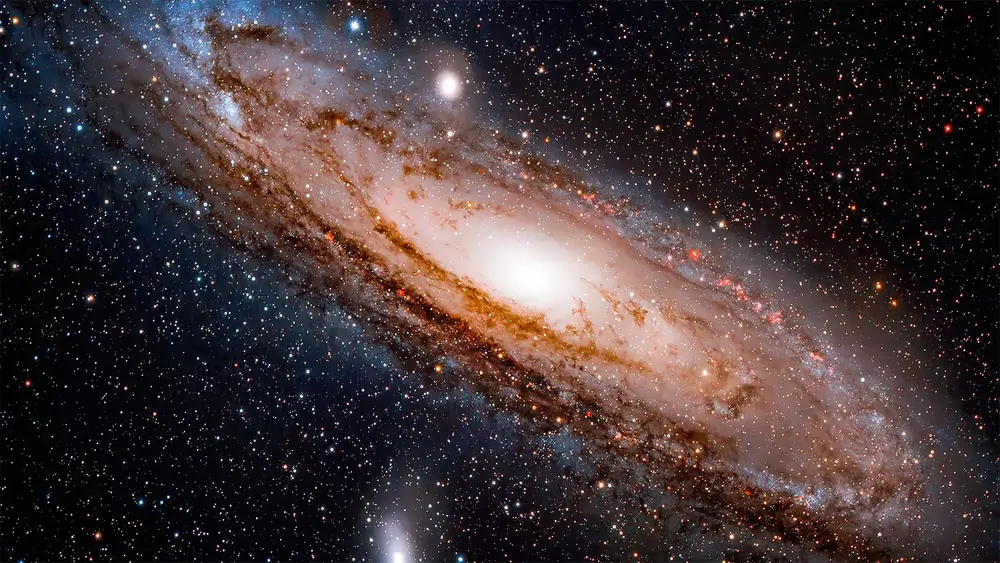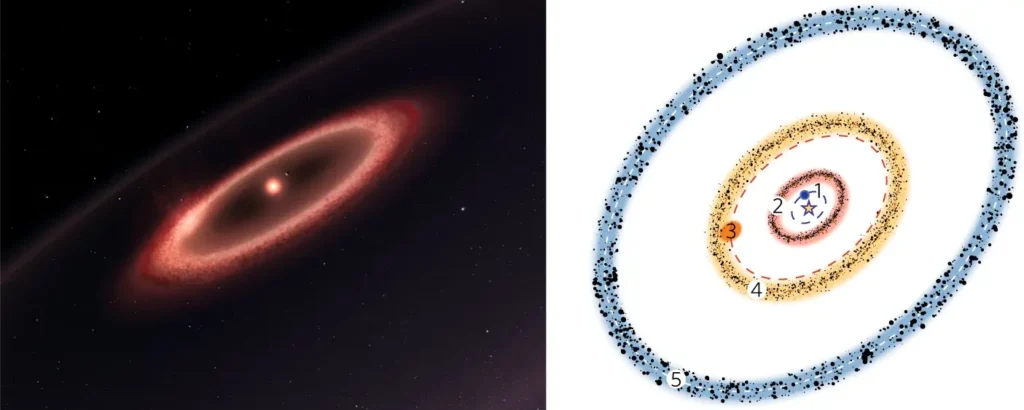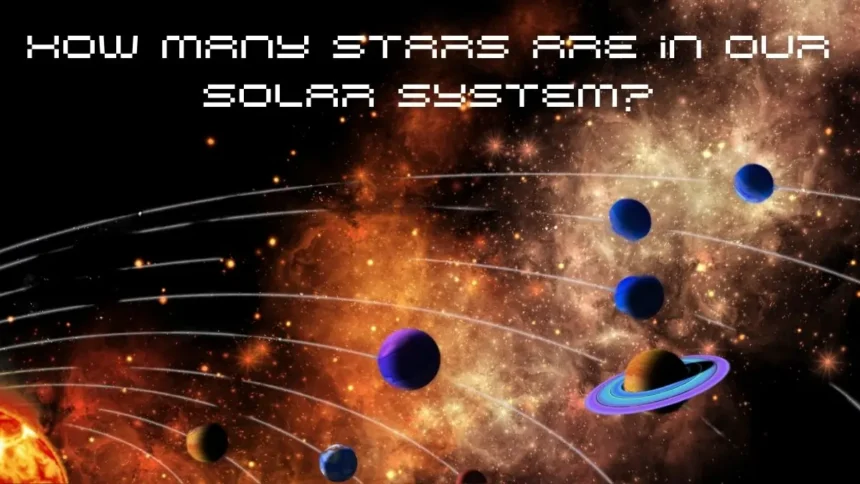Introduction
Have you ever gazed at the night sky and wondered about the stars? The question “How many stars are in our solar system?” might seem straightforward, but its answer reveals fascinating details about our cosmic neighborhood.
When we think about the vast universe teeming with countless stars, it’s intriguing to ask, how many stars are in our solar system? Surprisingly, our solar system is home to just one star: the Sun. This singular star plays a pivotal role in sustaining life on Earth, influencing the orbits of planets, and providing the necessary light and energy for our existence.
Understanding how many stars are in our solar system gives us insight into the Sun’s unique characteristics and central importance in the intricate dance of celestial bodies that define our solar system.
Read also: What is the Order of the Planets in the Solar System?
What is a Star?
A star is a big glowing ball of hot gas mainly consisting of hydrogen and helium. Its characteristics include a high temperature in its core, where clear fusion occurs, producing energy. Stars may appear fixed, but they rotate and differ in luminosity. The heat is generated by nuclear fusion, which causes the gas at the center of the star to radiate outer pressure.
Read also: How Many Earths Can Fit in the Sun?
What is the Solar System?
The Solar System is a fascinating collection of the Sun and all the astronomical objects that orbit it. It includes our star, the Sun, ending bound to it by gravity – from planets like Earth to asteroids, meteors, and comets. This unique system exists within the vast expanse of the Milky Way Galaxy, prompting the intriguing question: “How many stars are there in our solar system?”

Components of the Solar System
By exploring our Solar System’s structure, we can better understand its components and their roles within the broader context of our Galaxy. This includes the eight planets—Mercury, Venus, Earth, Mars, Jupiter, Saturn, Uranus, and Neptune—and dwarf planets such as Pluto, Ceres, Makemake, Haumea, and Eris. Additionally, there are hundreds of moons and millions of asteroids, comets, and meteoroids.
Read also: Planet Size Comparison – Epic Battle among 8 Planets of the Solar System
Read also: Biggest Planet in Our Solar System – Discover 9 Mind-blowing Facts about Jupiter
Historical Perspective of the Formation of the Solar System
The Big Bang introduced the universe to existence 13.8 billion years ago, but our solar system formed much later, around 4.6 billion years ago. It began as a massive cloud of dust and gas created from supernova debris—the remnants of dying stars. This cloud orbited the center of our galaxy, the Milky Way.
It mainly consisted of hydrogen, helium, and traces of heavier particles forged by earlier stars. Over the upcoming 100,000 years, the cloud collapsed under its gravity, forming hot, dense protostars, one of which became our Sun, the central star of our solar system that supports life on Earth.
Read also: 3 Most Important Theories to Explain How the Solar System Formed?
Sun – the Star of Our Solar System
The Sun is the central star around which Earth and all other components of our solar system revolve. Dominating the system with over 99 percent of its total mass, the Sun generates immense energy. This energy provides Earth with the light and heat necessary to support life.

Classified as a G2 V star, the Sun is the second hottest star of the yellow G class, with a surface temperature of about 5,800 kelvins (K). The V indicates it is a main sequence, or dwarf star, which is typical for this temperature class.
This raises the intriguing question: “How many stars are in our solar system?” Understanding the Sun’s role is crucial as we explore our solar system within the vast expanse of the Milky Way galaxy.
Read also: When will the Andromeda and Milky Way Galaxy Collide
Why Only One Star?
Our Sun, an ordinary star, is among hundreds of billions in the Milky Way Galaxy. As the only star we can see in detail, it is the foundation for understanding all stars. Consisting entirely of hydrogen and helium gas, the Sun’s properties and behavior provide crucial insights into stellar phenomena. This context leads us to the question: “How many stars are in our solar system?”
Read also: 7 Mind-Blowing Facts About Solar Atmospheres You Didn’t Know
Other Stars in the Milky Way Galaxy
A star is a big, self-luminous, astronomical body of gas that shines by radiating energy from internal sources. Many stars in the Milky Way Galaxy occur in pairs, multiple systems, or star clusters, where they are physically related through a common origin and bound by mutual gravitational attraction.

These stellar groups can be found in various constellations such as Aquila, Auriga, Boötes, Cancer, Canes Venatici, and Canis Major. This diversity of stars within our galaxy contrasts with the solitary star of our solar system, the Sun, prompting the question: “How many stars are there in our solar system?”
Common Misconceptions about the Galaxies:
Common misconceptions related to Galaxies include:
- Other galaxies could be a part of the solar system.
- The galaxies that are present are similar in appearance and composition
- We can easily look at the galaxies without the help of a telescope.
Exploring beyond our solar system
Nearest Stars
Proxima Centauri, the nearest star to the Sun, is still an immense 40.208 trillion kilometers away, equivalent to about 268,770 astronomical units (AU). To put this in perspective, a light-year—the distance light travels in one year—is approximately 9.461 trillion kilometers. Alpha Centauri A and B, roughly 4.35 light-years away from us, are slightly farther than Proxima Centauri, which is 4.25 light-years away.

Exoplanets and Other Systems
An exoplanet is any planet located beyond our solar system. While most exoplanets orbit other stars, there are also free-floating exoplanets, known as rogue planets, which are not bound to any star. The existence of more than 5,200 exoplanets out of the billions believed to exist has been confirmed.
Most of the exoplanets discovered so far are located within a relatively small region of our galaxy, the Milky Way. This “small” region spans thousands of light-years from our solar system. Considering that one light-year equals approximately 5.88 trillion miles or 9.46 trillion kilometers, the discovered exoplanets are still relatively close in the vast expanse of our galaxy.
Read also: Exploring exoplanets: a journey towards the Distant Worlds
Importance of the Solar System
Stability and Life on Earth
The stability of life on Earth is primarily linked to the unique conditions of our solar system in the Milky Way galaxy. Placed in a relatively composed region of the galaxy, away from the more chaotic center, the solar system provides the stable atmosphere required for life to exist. Earth revolves around the sun, a protective magnetic field, and the atmosphere, ensuring the proper temperature balance and protection from harmful cosmic rays.
Read also: How many solar systems are in the milky way galaxy
Role in the Milky Way Galaxy
Earth, our home, is essential for our existence in numerous ways. We depend on its resources for sustenance and the materials that support our way of life. Positioned within the Milky Way galaxy, even modest changes to Earth’s systems can profoundly impact human societies and the course of civilization. The stability provided by Earth’s unique conditions within our galaxy has been crucial for the development and sustainability of life.
Conclusion
In conclusion, exploring the question “How many stars are in our solar system?” reveals a fundamental truth: our solar system contains only one star, the Sun. This single star is the center of our solar system, providing the necessary light and energy that sustains life on Earth and governs the orbits of the planets. The Sun’s unique position and role highlight its importance in the vast expanse of space.
Understanding how many stars are in our solar system underscores the singularity and significance of the Sun in maintaining the delicate balance of our cosmic neighborhood. While the night sky is filled with countless stars, the Sun defines our solar system, a reminder of the intricate and wondrous design of the universe. By appreciating this, we gain a deeper respect for the celestial mechanics that sustain our existence.
FAQs
1. How many stars are in our solar system?
There is only one star in our solar system: the Sun. While the night sky is filled with countless stars, they all belong to other solar systems far beyond our own. The Sun is a massive ball of hot plasma that provides light and heat, making life on Earth possible.
2. Why do we see so many stars if there’s only one in our solar system?
The stars we see at night are incredibly distant suns, each potentially with its solar system. The Milky Way galaxy alone contains hundreds of billions of stars. Due to the vast distances involved, even the closest stars appear as tiny points of light.
3. What is the difference between a star and a planet?
Stars are enormous celestial bodies of hydrogen and helium that produce light and heat through nuclear fusion. On the other hand, planets are celestial bodies that orbit a star, are massive enough to be rounded by their own gravity, and have cleared their neighboring region of planetesimals.
4. What is the closest star to our solar system?
Proxima Centauri is the closest star to our solar system, a red dwarf star located about 4.24 light-years away. It’s part of a triple star system known as Alpha Centauri. While it’s the closest, it’s too faint to be seen with the naked eye.
5. Are there other solar systems like ours?
Yes, billions of other solar systems are in our galaxy alone, and many likely have planets. Scientists have discovered thousands of exoplanets (planets outside our solar system) orbiting other stars, suggesting that planetary systems are quite common.
6. Can other solar systems support life?
The possibility of life in other solar systems is a subject of ongoing research and debate. For a planet to potentially support life as we know it, it would need to be within the “habitable zone” of its star, where conditions are suitable for liquid water to exist. Several exoplanets have been found in this zone, raising the intriguing possibility of extraterrestrial life.
7. How do stars form?
Stars form within giant clouds of gas and dust called nebulae. Over time, gravity pulls the material in these clouds together, causing them to collapse. As the cloud collapses, it spins faster, creating a dense, hot core. When the core reaches a critical temperature, nuclear fusion begins, and a star is born.
8. How long do stars live?
The lifespan of a star depends on its mass. Massive stars burn through their fuel much faster than smaller stars and may only live for a few million years. Smaller stars, like our Sun, can live for billions of years. When a star runs out of fuel, it will eventually die in a spectacular supernova explosion (for massive stars) or gradually disappear as a white dwarf (for smaller stars).
References
- Solar system exploration. (2023, June 8). Nasa.gov. https://science.nasa.gov/solar-system/
- What is the solar system? (2022, July 4). Byjus.com; BYJU’S. https://byjus.com/question-answer/what-is-solar-system-2/
- Solar system history 101. (2021, January 14). The Planetary Society. https://www.planetary.org/articles/solar-system-history-101
- Sun – Core, Radiation, Layers. (n.d.). In Encyclopedia Britannica.
- Our star-the Sun. (n.d.). American Museum of Natural History. Retrieved May 23, 2024, from https://www.amnh.org/exhibitions/permanent/the-universe/stars/our-star-the-sun
- The Editors of Encyclopedia Britannica. (2015). list of stars. In Encyclopedia Britannica.
- (N.d.). Usra.edu. Retrieved May 23, 2024, from https://www.lpi.usra.edu/education/pre_service_edu/GalaxiesMisconceptions.shtml
- Mattson, B. (n.d.). Imagine the universe! Nasa.gov. Retrieved May 23, 2024, from https://imagine.gsfc.nasa.gov/features/cosmic/nearest_star_info.html
- What is the importance of earth science literacy? (n.d.). Faculty of Science. Retrieved May 23, 2024, from https://science.uct.ac.za/department-geological-sciences/outreach-earth-science-literacy-initiative-esli/importance-earth-science-literacy





